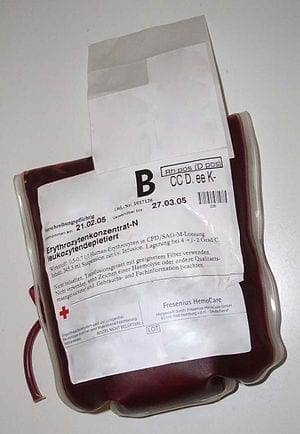
Researchers from Case Western Reserve University School of Medicine have developed an unprecedented approach to restore nitric oxide (NO) to donated blood, a breakthrough that could dramatically reduce harmful effects from transfusions.
Jonathan Stamler, MD, and colleagues from Case Western Reserve School of Medicine and from Duke University Medical Center describe their findings in the June 24 issue of PNAS: Proceedings of the National Academy of Sciences of the United States of America. Stamler and his colleagues report that restoring blood levels of NO in animals prior to transfusion improved their tissue blood flow, oxygen delivery, and kidney function.
Patients in the U.S. receive approximately 15 million blood transfusions a year. The procedure is often used to replace blood lost through trauma, but also can supplement shortages in a patient’s own ability to produce blood due to cancer and other diseases. Increasingly, medical research publications associate transfusions with harmful consequences including heart attacks, renal failure, and death. A compelling explanation put forward in the literature is that the quantity of NO declines rapidly after donation because it has a short lifespan. Normally, NO dilates blood vessels and allows red blood cells to access tissue and deliver oxygen.
In the blood, NO exists in a bioactive form called S-nitrosohemoglobin (SNO-Hb). The unique process Stamler and team developed to restore SNO-Hb — so-called renitrosylation therapy — could have significant benefits for millions of patients.
“Inasmuch of the world’s supply of banked blood is deficient in SNO-Hb, efforts to restore its levels may hold great therapeutic promise,” said Stamler, director, Institute for Transformative Molecular Medicine and the Robert S. and Sylvia K. Reitman Family Foundation Distinguished Chair in Cardiovascular Innovation, Case Western Reserve School of Medicine and University Hospitals (UH) Case Medical Center, and director, Harrington Discovery Institute, UH Case Medical Center.
“One important aspect of our study is the insight that knowledge of banked blood’s SNO-Hb status may be used to judge the efficacy of a transfusion,” Stamler said.
This information would allow physicians to discriminate between blood donations that may cause harm versus those that will have restorative effects following transfusion.
The research team hypothesized that the loss of NO compromises the ability to dilate blood vessels and thereby deliver oxygen to tissues, which is critical for survival. Red blood cells lacking NO instead would plug small blood vessels and cause heart attacks and kidney failure. In contrast, restoration of NO would ensure oxygen delivery.
The study, funded by the National Heart Lung and Blood Institute (NHLBI), found that mice, rats and sheep transfused with untreated banked blood had decreased oxygen levels in skeletal muscle and other tissues—exactly the opposite of what would have been predicted. By contrast, in animals transfused with renitrosylated (NO repleted) red blood cells, tissue oxygenation improved. In addition, researchers applied the same treatment to anemic animals and found improved blood flow, tissue oxygenation, and kidney function.
Stamler explained that these results demonstrate that restoration of blood NO levels may be useful in treating and preventing a wide variety of conditions, including heart attacks and strokes, and kidney damage following surgery. The findings also may offer new promise for patients with sickle disease, malaria and other blood disorders. In addition, the data suggest that Stamler’s therapeutic is a simple way to reverse the potential toxicity of regular blood transfusions.
The Latest Bing News on:
Blood Transfusions
- Northern Colorado mother saved by blood donation during childbirth hosts blood drives to save otherson May 7, 2024 at 6:36 pm
Everybody has a mother, knows a mother, or loves a mother, McMeekin said. “It could have been anyone’s mother who needed blood.” ...
- Cancer patients facing blood transfusion delays at the MUHCon May 7, 2024 at 3:44 am
Cancer patients in need of blood transfusions have been facing delays because of a “grave shortage” of medical technologists at the McGill Univerity Health Centre , The Gazette has learned. The MUHC, ...
- Infected blood scandal greatest injustice country has seen, claims Andy Burnhamon May 6, 2024 at 11:13 pm
The infected blood scandal saw thousands of people in the UK in the 70s and 80s given blood transfusions or blood products that were infected with viruses such as Hepatitis B, Hepatitis C, and HIV.
- Blood Drive in Memory of Bethany Bohn set for Friday, May 10 in Godfreyon May 6, 2024 at 12:31 pm
GODFREY - Family and friends of Bethany Bohn will hold a blood drive in her memory on Friday, May 10 in Godfrey. The former Clerk for the Village of Godfrey ...
- Groundbreaking discovery could create 'universal donor blood' for first time everon May 5, 2024 at 12:20 am
The way this breakthrough could be possible is thanks to a bacteria enzyme that's found in almost everyone's guts. It's an enzyme that removes antigens from red blood cells, which is something that ...
- Infected blood death stigma drove widow and son overseason May 5, 2024 at 12:11 am
Stigma surrounding the death of Aberdeen church elder John Strachan was so severe that it forced his widow to emigrate. Having contracted HIV from one of his regular blood transfusions, the ...
- Scientists may have found a way to make a universal donor bloodon May 4, 2024 at 12:10 pm
Scientists have found a type of bacteria enzyme that can strip away blood types and create universal donor blood.
- Blood transfusion from dog blood bank saves police K-9on May 2, 2024 at 11:46 am
LAS VEGAS, Nev. ( KVVU /Gray News) - A police K-9 was saved after receiving a blood transfusion from a dog blood bank. In March, Las Vegas Metropolitan Police K-9 Enzo was airlifted to Las Vegas ...
- Blood transfusion from dog blood bank saves police K-9on May 2, 2024 at 7:47 am
LAS VEGAS, Nev. (KVVU/Gray News) - A police K-9 was saved after receiving a blood transfusion from a dog blood bank. In March, Las Vegas Metropolitan Police K-9 Enzo was airlifted to Las Vegas ...
- Bacterial enzyme strips away blood types to create universal donor bloodon April 29, 2024 at 9:44 pm
Using enzymes produced by a bacteria that almost everyone has in their gut, researchers have removed the antigens from red blood cells that determine blood type, putting us within reach of producing ...
The Latest Google Headlines on:
Blood Transfusions
[google_news title=”” keyword=”Blood Transfusions” num_posts=”10″ blurb_length=”0″ show_thumb=”left”]
The Latest Bing News on:
Restoring blood levels of NO
- Look closely at Howard Schultz's recent advice on how to fix Starbucks, and a key insight emerges.on May 6, 2024 at 6:23 am
The former Starbucks CEO published a LinkedIn post yesterday, calling out the company's poor performance and pointing out how to fix it. Schultz says leaders need to "model both humility and ...
- Treatment for peripheral artery disease as effective for women as menon May 3, 2024 at 11:32 am
Less invasive endovascular treatments work equally well in women as in men with peripheral artery disease, a new study found.
- Nuked blood: cover-up could wreck £20bn Trident deal, warns ex-defence ministeron May 3, 2024 at 7:48 am
The continuing scandal of missing blood tests from UK troops could make it hard to convince ... which may refer to atomic experiments on servicemen should be published to restore public trust, and ...
- Gray Zone Warfare: How to restore hydration, energy, and blood without using items in GZWon May 1, 2024 at 10:47 am
Gray Zone Warfare GZW Gray Zone Warfare safely end deployment once you’re back at your Base Camp. doing so takes little time, costs nothing, and fully regenerates your hydration, energy, and blood ...
- Blood test finds knee osteoarthritis up to 8 years before it appears on X-rayson April 26, 2024 at 3:22 pm
Detecting knee osteoarthritis with a blood test up to eight years before it appears on X-rays -- as researchers have done -- could lead to therapies that delay disease progression and restore joint ...
- Tips for restoring, maintaining mobility after age 50on April 26, 2024 at 1:24 am
These everyday tasks require a base level of mobility ... a drill that can maintain and aid in restoring joint health. (Doug Sheppard) A daily routine can consist of the following: Start ...
- Anglo must restore productivity levels, says former bosson April 8, 2024 at 5:00 pm
AFTER the brickbats come the plaudits. Or is it better to describe the positive ripple in Anglo American’s share price this year as a case of absolution? In any case, the JSE bellwether registered a ...
- One of most commonly prescribed statins raises diabetes risk: studyon December 20, 2023 at 7:27 pm
But while taking rosuvastatin, provided under the brand name Crestor among others, is associated with lower cholesterol levels ... procedures to restore blood flow to parts of the heart.
- Global bid to restore blood stocks to pre-pandemic levelson August 30, 2022 at 11:34 am
Australians have joined people in 19 other countries in a world record attempt for the largest number of blood donors over a 24-hour period. Sign up now for the latest news from Australia and ...
- Treating kidney failure by dialysison July 25, 2020 at 9:11 pm
In this procedure, patients are connected to a dialysis machine which acts as an artificial kidney to remove most of the urea and restore ... levels of urea – it is 'cleaned blood' no overall ...
The Latest Google Headlines on:
Restoring blood levels of NO
[google_news title=”” keyword=”restoring blood levels of NO” num_posts=”10″ blurb_length=”0″ show_thumb=”left”]










